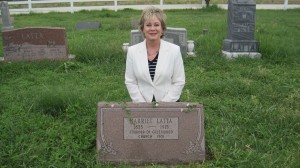Lane Dolly at Hattie’s grave near Fargo, OK
One Hundred Years. It’s hard to wrap your mind around such a long time. Very few people live to be that old. But, the other night, I sat open-mouthed in Tulsa, OK listening to a one hundred year old woman play Christmas carols on a restored grand piano of the same vintage. Everybody else at the recital looked as awed as I felt.
The touching significance of her performance centered my thoughts upon time, life, death, and how much can happen in one hundred years. I pictured the woman pianist as an infant in 1915 and let my thoughts float back through time from there. If only I could have been alive back then, too.
That year was a time of significance and sorrow in the same state of Oklahoma among members of my own family. A little, rural church in the western part of the state was the setting that spring of 1915 for a gathering in a tight-knit community. Its citizens, neighbors, and friends had come together to mourn and memorialize my great-great grandmother, Hattie Sheldon Latta. She was eighty one years old and had actually founded that church and the cemetery nearby that became her final resting place.
Hattie’s amazing life story almost got lost during the century from 1915 to 2015. But a strong push from an unknown place urged me to discover it anew and make her the heroine and protagonist of a series of books. To piece together Hattie’s unusual life of travels and trials, to recreate her happiness and hardship, and to discover the extent of her commitment and service, I worked hard. There was joy and exhaustion as I drove dusty roads and interstate highways on the way to libraries, cemeteries, museums and historical societies from Washington, DC to Oklahoma to Massachusetts to New York State.
As a result, Hattie’s unforgettable achievements became a motivating road map for how to live the second half of my own life. She now serves as a role model in absentia, but is very much alive in my heart and mind. If I might mirror even half of her depth of character, I would do well.
As the end of 2015 approaches, Hattie is very close to the forefront of my thoughts. When I drive the long trek from eastern to western Oklahoma, I think of her on a particular stretch of road that meanders through a sparsely inhabited place. In Ellis County, a little green sign, skinny and easy to miss, stands proudly. I always watch for it. That’s because, by the time I’ve reached that spot, I’ve been driving over two hundred miles and am a bit tired. That place and the sign have evolved into a reminder, really, to keep going, just as Hattie must have done to live so virtuously for so long. The sign has one word and an arrow that points south to the hilly top of a ridge. I know from experience what’s up there because I’ve turned off many times.
The simple sign says “Cemetery.” If you follow the arrow just past the crest of the ridge, there’s a rusty metal gate by the roadside that opens west into a quiet place. There, I’ve read and reread a host of names carved lovingly into handsome, sturdy stones. It’s Hattie’s resting place and that of her children, fellow church members, other homesteaders, and beloved friends. It’s peaceful up there listening to the prevailing southwest breeze rush through the prairie grasses.
I will make that long drive across my home state many times during the rest of my life. And I find encouragement even when I’m hurrying and cannot turn off the main highway to pay my respects. On those busy days, I roll down the car window, speak and wave to acknowledge that that place and Hattie’s life maintain their abiding value. It may have been one hundred years since Hattie’s life on earth ended, but her influence and story are remembered. Rest peacefully, Hattie, and bless you for making my life – and my books about your life – possible.
